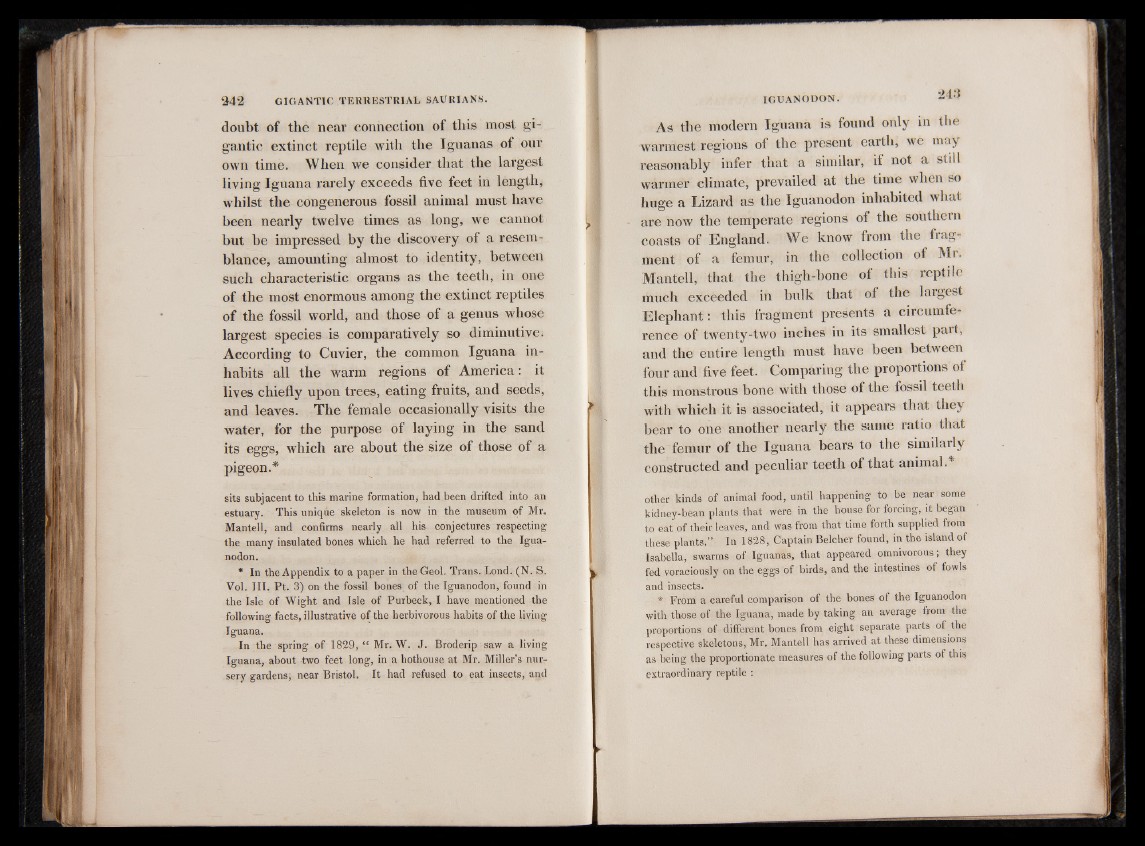
doubt of the near connection of this most gigantic
extinct reptile with the Iguanas of our
own time. When we consider that the largest
living Iguana rarely exceeds five feet in length,
whilst the congenerous fossil animal must have
been nearly twelve times as long, we cannot
but be impressed by the discovery of a resemblance,
amounting almost to identity, between
such characteristic organs as the teeth, in one
of the most enormous among the extinct reptiles
of the fossil world, and those of a genus whose
largest species is comparatively so diminutive.
According to Cuvier, the common Iguana inhabits
all the warm regions of America: it
lives chiefly upon trees, eating fruits, and seeds,
and leaves. The female occasionally visits the
water, for the purpose of laying in the sand
its eggs, which are about the size of those of a
pigeon.*
sits subjacent to this marine formation, had been drifted into an
estuary. This unique skeleton is now in the museum of Mr.
Mantell, and confirms nearly all his conjectures respecting
the many insulated bones which he had referred to the Igua-
nodon.
* In the Appendix to a paper in the Geol. Trans. Lond. (N. S.
Vol. III. Pt. 3) on the fossil bones of the Iguanodon, found in
the Isle of Wight and Isle of Purbeck, I have mentioned the
following facts, illustrative of the herbivorous habits of the living
Iguana.
In the spring of 1829, “ Mr. W. J. Broderip saw a living
Iguana, about two feet long, in a hothouse at Mr. Miller’s nursery
gardens; near Bristol. It had refused to eat insects, and
As the modern Iguana is found only in the
warmest regions of the present earth, we may
reasonably infer that a similar, if not a still
warmer climate, prevailed at the time when so
huge a Lizard as the Iguanodon inhabited what
are now the temperate regions of the southern
coasts of England. We know from the fragment
of a femur, in the collection of Mr.
Mantell, that the thigh-bone of this reptile
much exceeded in bulk that of the largest
Elephant: this fragment presents a circumference
of twenty-two inches in its smallest part,
and the entire length must have been between
four and five feet. Comparing the proportions of
this monstrous bone with those of the fossil teeth
with which it is associated, it appears that they
bear to one another nearly the same ratio that
the femur of the Iguana bears to the similarly
constructed and peculiar teeth of that animal.*
other kinds of animal food, until happening to be near some
kidney-bean plants that were in the house for forcing, it began
to eat of their leaves, and was from that time forth supplied from
these plants.” In 1828, Captain Belcher found, in the island of
Isabella, swarms of Iguanas, that appeared omnivorous; they
fed voraciously on the eggs of birds, and the intestines of fowls
and insects.
* From a careful comparison of the bones of the Iguanodon
with those of the Iguana, made by taking an average from the
proportions of different bones from eight separate parts of the
respective skeletons, Mr. Mantell has arrived at these dimensions
as being the proportionate measures of the following parts of this
extraordinary reptile :